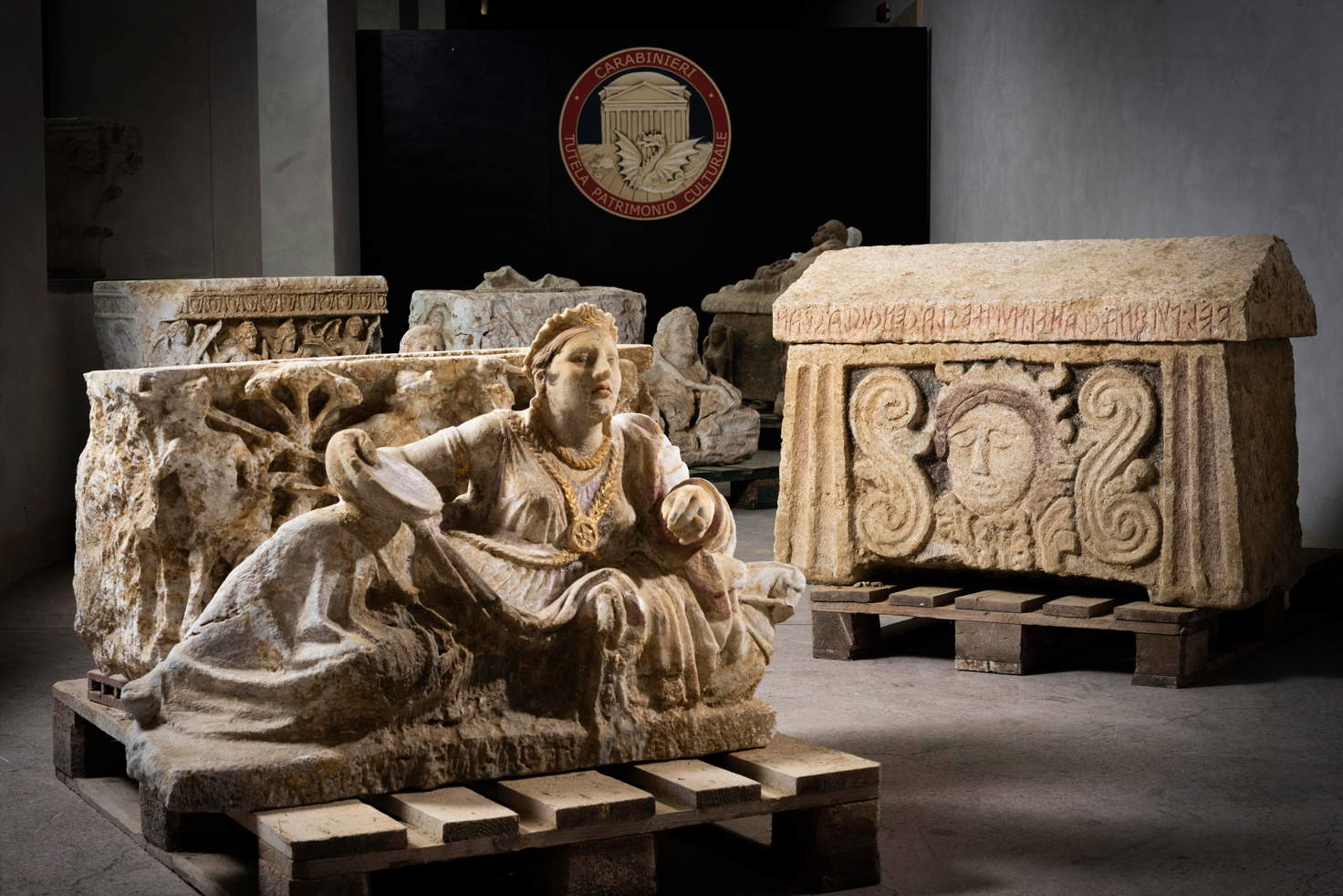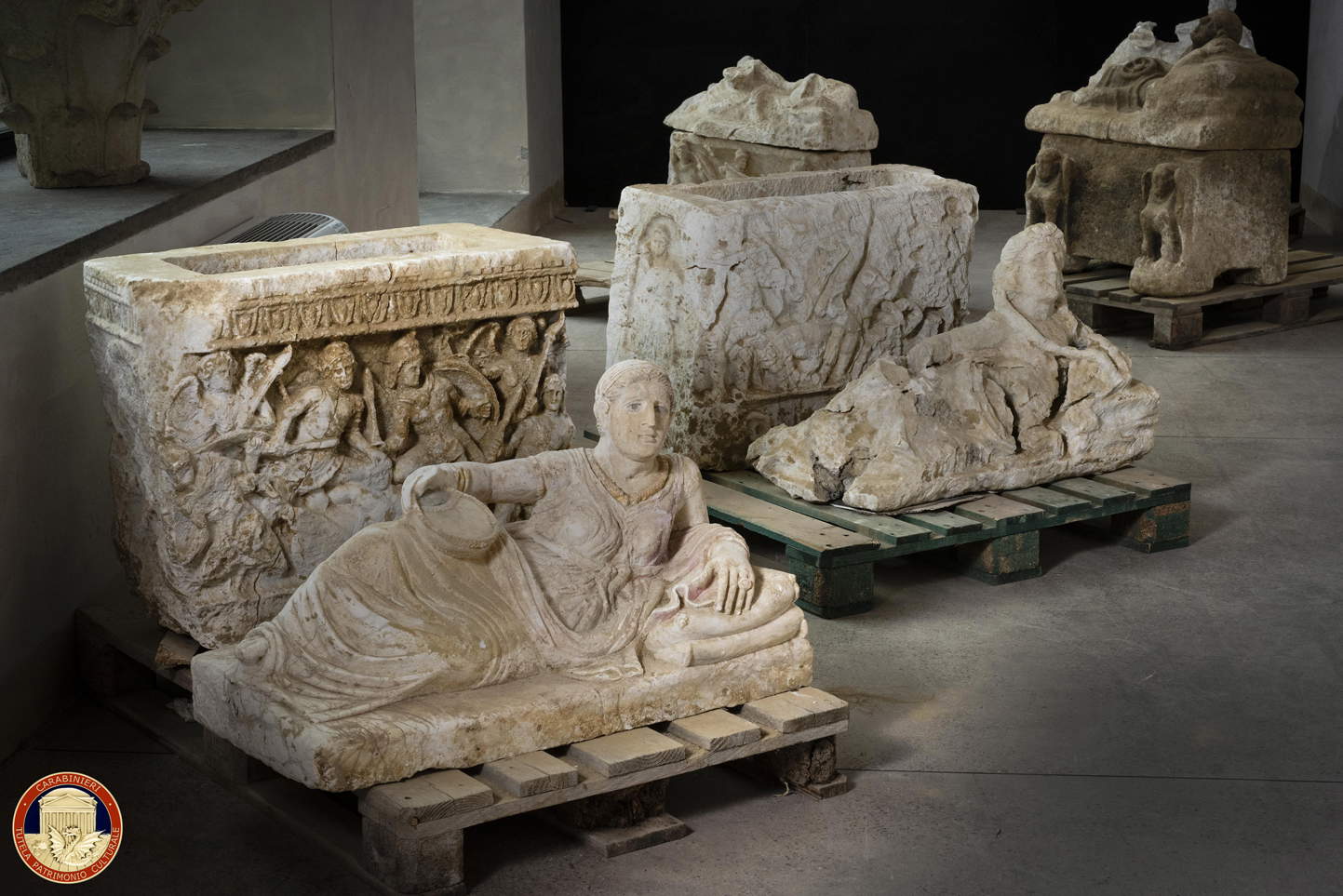TPC Carabinieri seize numerous Etruscan archaeological artifacts in perfect condition
Carabinieri from the Nucleo Tutela Patrimonio Culturale - archaeology section, coordinated by the Public Prosecutor’s Office at the Court of Perugia, presented today, in Rome, at the headquarters of the Operational Department of the Carabinieri Tutela Patrimonio Culturale Command, the complex and articulated investigation activity within the scope of which numerous archaeological finds from the Etruscan age were seized in perfect preservation. The activities were initiated last April, following a communication from the Carabinieri’s Cultural Heritage Protection Command reporting a possible illegal excavation in the area between Chiusi and Città della Pieve and the discovery of important Etruscan archaeological finds. Thus began the investigation, carried out by the Archaeology Section of the TPC Operational Department, from theacquisition of photographs depicting cinerary urns with semi-recumbent figures, typical of Etruscan culture, circulating on the illicit art market. Scientific collaboration by a professor from the University of Rome Tor Vergata made it possible to contextualize the findings’ belonging to an Etruscan necropolis, likely from the Chiusi area already rich in similar artistic evidence. Further investigations, with the specialized support of the Ministry of Culture’s General Directorate of Archaeology, Fine Arts and Landscape and the Superintendence of Umbria, allowed the focus to be placed on a chance find, already reported in 2015 in Città della Pieve: while plowing the land, a farmer had come across an Etruscan hypogeum containing four funerary urns and two sarcophagi traceable to the gens Pulfna, whose patronymic itself was present on some of the very urns depicted in the photographs to be searched. While the Pulfna hypogeum discovered in 2015 consisted of male burials, the pictures depicted mainly Etruscan princesses. Therefore, investigations were focused on locations adjacent to the Umbrian site in order to ascertain whether other hypogea had been breached recently.
Having assessed the need for adequate equipment and mechanical means for handling and transporting such finds, given the weight and size of the urns, the Carabinieri focused on individuals deemed capable of handling the complex operations of a clandestine recovery. The analysis of additional data acquired in local administrative archives and interpolation with the elements collected in the first phase of the investigation, allowed them to focus their investigative interest on a local entrepreneur, the owner of a company also capable of carrying out earthmoving, who owned land adjacent to that where the hypogeum had been discovered in 2015.
After the TPC military had confirmation of an imminent commercialization of the goods on the clandestine antiquities market, authorization was requested from the gip to conduct telephone wiretaps, an activity also supported by observation and tailing services, with the use of a drone supplied by the Carabinieri Helicopter Unit at Pratica di Mare. This allowed the presence of the artifacts to be most likely identified within a well-defined area in the territory of Città della Pieve. A local search warrant was issued, and in the course of execution the very urns depicted in the photographs were identified.
In addition, also using topographical elements acquired from the drone, the TPC military precisely identified the excavation site. In particular, two people were identified as possible perpetrators, against whom the crimes of theft and receiving of cultural property are being prosecuted, and most importantly, eight Etruscan lithic urns, two sarcophagi and related funerary accoutrements from the Hellenistic period of the 3rd century B.C. were seized. The urns, all intact, are made of white Umbrian travertine, partly decorated in high relief with battle and hunting scenes and with friezes, some of which retain polychrome pigments and gold-leaf coverings, others with depictions of the myth of Achilles and Troilus. Of the two sarcophagi, one is currently represented by the cover only and the other is also complete with the skeleton of the deceased.
A preliminary scientific study of the urns by archaeological officials of the Ministry of Culture confirms that the goods belong to a single funerary context, consisting of a hypogeum tomb traceable to an important local family, the “Pulfna.”
There is also a wealth of grave goods, consisting of both fictile and metallic furnishings and vessels, including four bronze mirrors, one of them with the ancient deification of Rome and the she-wolf suckling Romulus, a balsam jar still containing organic traces of the perfume used in antiquity, a bone comb, bronze situlae and oinochoe, commonly used by Etruscan women during banquets and symposia. This is, according to experts, one of the most important recoveries of Etruscan artifacts ever made during an investigative action. Moreover, the circumstance that the seized works are referable to a single hypogeum makes the archaeological, artistic and historical value of the recovery itself particularly relevant.


 |
| TPC Carabinieri seize numerous Etruscan archaeological artifacts in perfect condition |
Warning: the translation into English of the original Italian article was created using automatic tools. We undertake to review all articles, but we do not guarantee the total absence of inaccuracies in the translation due to the program. You can find the original by clicking on the ITA button. If you find any mistake,please contact us.



























